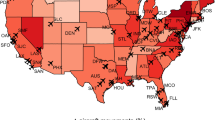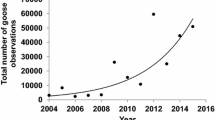Abstract
Wildlife incidents with aircraft cost the United States (U.S.) civil aviation industry >US$1.4 billion in estimated damages and loss of revenue from 1990 to 2009. Although terrestrial mammals represented only 2.3 % of wildlife incidents, damage to aircraft occurred in 59 % of mammal incidents. We examined mammal incidents (excluding bats) at all airports in the Federal Aviation Administration (FAA) National Wildlife Strike Database from 1990 to 2010 to characterize these incidents by airport type: Part-139 certified (certificated) and general aviation (GA). We also calculated relative hazard scores for species most frequently involved in incidents. We found certificated airports had more than twice as many incidents as GA airports. Incidents were most frequent in October (n = 215 of 1,764 total) at certificated airports and November (n = 111 of 741 total) at GA airports. Most (63.2 %) incidents at all airports (n = 1,523) occurred at night but the greatest incident rate occurred at dusk (177.3 incidents/hr). More incidents with damage (n = 1,594) occurred at GA airports (38.6 %) than certificated airports (19.0 %). Artiodactyla (even-toed ungulates) incidents incurred greatest (92.4 %) damage costs (n = 326; US$51.8 million) overall and mule deer (Odocoileus hemionus) was the most hazardous species. Overall, relative hazard score increased with increasing log body mass. Frequency of incidents was influenced by species relative seasonal abundance and behavior. We recommend airport wildlife officials evaluate the risks mammal species pose to aircraft based on the hazard information we provide and consider prioritizing management strategies that emphasize reducing their occurrence on airport property.








Similar content being viewed by others
References
Armitage KB (2003) Marmots (Marmota monac and allies). In: Feldhamer GA, Thompson BC, Chapman JA (eds) Mammals of North America: biology, management and conservation, 2nd edn. Johns Hopkins University Press, Maryland, pp 188–210
Baker RJ, Bradley LC, Bradley RD, Dragoo JW, Engstrom MD, Hoffmann RS, Jones CA, Reid F, Rice DW, Jones C (2003) Revised checklist of North American mammals north of Mexico. Occasional Papers, Museum of Texas Tech University 229:1–23
Bekoff M, Gese EM (2003) Coyote (Canis latrans). In: Feldhamer GA, Thompson BC, Chapman JA (eds) Mammals of North America: biology, management and conservation, 2nd edn. Johns Hopkins University Press, Maryland, pp 468–481
Belant JL, Seamans TW, Dwyer CP (1996) Evaluation of propane exploders as white-tailed deer deterrents. Crop Protection 15:575–578
Belant JL, Seamans TW, Dwyer CP (1998) Cattle guards reduce white-tailed deer crossings through fence openings. International Journal of Pest Management 44:247–249
Biondi KM, Belant JL, Martin JA, DeVault TL, Wang G (2011) White-tailed deer incidents with U.S. civil aircraft. Wildl Soc Bull 35:303–309
Biondi KM, Belant JL, Martin JA, DeVault TL, Wang G (2013) Bat incidents with U.S. civil aircraft. Acta Chiropterologica 15:185–192
Bissonette J, Kassar CA, Cook LJ (2008) Assessment of costs associated with deer–vehicle collisions: human death and injury, vehicle damage, and deer loss. Human-Wildlife Conflicts 2:17–27
Blackwell BF, Seamans TW (2009) Enhancing the perceived threat of vehicle approach to deer. Journal of Wildlife Management 73:128–135
Bomford M, O’Brien PH (1990) Sonic deterrents in animal damage control: a review of device tests and effectiveness. Wildl Soc Bull 18:411–422
Cleary EC, Dickey A (2010) Guidebook for addressing aircraft/wildlife hazards at general aviation airports. In: Airport Cooperative Research Program Report 32. Washington, DC
Cleary EC, Dolbeer RA (2005) Wildlife hazard management at airports, a manual for airport personnel. United States Department of Transportation, Federal Aviation Administration, Office of Airport Safety and Standards. Washington, DC
Conover MR (2002) Resolving human-wildlife conflicts: the science of wildlife damage management. Lewis Publishers, Florida
Craven SR, Hyngstrom SE (1994) Deer. In: Hyngstrom SE, Timm RM, Larson GE (eds) Prevention and control of wildlife damage. University of Nebraska Cooperative Extension Service, Nebraska, pp D25–D40
Cypher BL (2003) Foxes (Vulpes species, Urocyon species, and Alopex lagopus). In: Feldhamer GA, Thompson BC, Chapman JA (eds) Mammals of North America: biology, management and conservation, 2nd edn. Johns Hopkins University Press, Maryland, pp 511–546
D’Angelo GJ, De Chicchis AR, Osborn DA, Gallagher GR, Warren RJ, Miller KV (2007) Hearing range of white-tailed deer as determined by auditory brainstem response. Journal Wildlife Management 71:1238–1242
DeNicola AJ, Williams SC (2008) Sharpshooting suburban white-tailed deer reduces deer–vehicle collisions. Human-Wildlife Conflicts 2:28–33
DeVault TL, Kubel JE, Glista DJ, Rhodes OE (2008) Mammalian hazards at small airports in Indiana: impact of perimeter fencing. Human-Wildlife Conflicts 2:240–247
DeVault TL, Belant JL, Blackwell BF, Seamans TW (2011) Interspecific variation in wildlife hazards to aircraft: implications for airport wildlife management. Wildl Soc Bull 35:394–402
Dolbeer RA (2006) Height distributions of birds recorded by collision with civil aircraft. Journal Wildlife Management 70:1345–1350
Dolbeer RA (2009) Wildlife strike reporting, part 2–sources of data in voluntary system. U.S. Department of Transportation, Federal Aviation Administration Report DOT/FAA/AR-09/63. Washington, DC
Dolbeer RA, Wright SE (2009) Safety management systems: how useful will the FAA National Wildlife Strike Database be? Human-Wildlife Conflicts 3:167–178
Dolbeer RA, Wright SE, Cleary EC (2000) Ranking the hazard level of wildlife species to aviation. Wildl Soc Bull 28:372–378
Dolbeer RA, Begier MJ, Wright SE (2008) Animal ambush: the challenge of managing wildlife hazards at general aviation airports. Proceedings of Corporate Aviation Safety Seminar 53:1–17
Dolbeer RA, Wright SE, Weller J, Begier MJ (2012) Wildlife strikes to civil aircraft in the United States 1990–2010. U.S Department of Transportation, Federal Aviation Administration, Office of Airport Safety and Standards, Serial Report n. 17. Washington, DC
Dussault C, Poulin M, Courtois R, Ouellet J (2006) Temporal and spatial distribution of moose-vehicle accidents in the Laurentides Wildlife Reserve, Quebec, Canada. Wildlife Biology 12:415–425
Federal Aviation Administration (FAA) (2004) Deer hazard to aircraft and deer fencing. U.S. Department of Transportation, Federal Aviation Administration, CertAlert 04-16 Washington, DC
Federal Aviation Administration (FAA) (2010) FAA airport data. FAA airport facilities data report. http://www.faa.gov/airports/airport_safety/airportdata_5010/. Accessed 1 Nov 2010
Federal Aviation Administration (FAA) (2012a) Part 139 Airport Certification. http://www.faa.gov/airports/airport_safety/part139_cert/. Accessed 27 Feb 2012
Federal Aviation Administration (FAA) (2012b) FAA summary data. APO TAF quick data summary report. http://aspm.faa.gov/main/taf.asp. Accessed 20 Feb 2012
Federal Aviation Administration (FAA) (2012c) FAA air traffic activity system. http://aspm.faa.gov/opsnet/sys/Airport.asp. Accessed 28 Feb 2012
Feldhamer GA, Thompson BC, Chapman JA (eds) (2003) Mammals of North America: biology, management and conservation, 2nd edn. Johns Hopkins University Press, Maryland
Flinders JT, Chapman JA (2003) Black-tailed jackrabbit (Lepus californicus and allies). In: Feldhamer GA, Thompson BC, Chapman JA (eds) Mammals of North America: biology, management and conservation, 2nd edn. Johns Hopkins University Press, Maryland, pp 126–146
Gardner AL, Sunquist ME (2003) Opossum (Didelphis virginiana). In: Feldhamer GA, Thompson BC, Chapman JA (eds) Mammals of North America: biology, management and conservation, 2nd edn. Johns Hopkins University Press, Maryland, pp 3–29
Gehrt SD (2003) Raccoon (Procyon lotor and allies). In: Feldhamer GA, Thompson BC, Chapman JA (eds) Mammals of North America: biology, management and conservation, 2nd edn. Johns Hopkins University Press, Maryland, pp 611–634
Grilo C, Bissontte JA, Santos-Reis M (2009) Spatial–temporal patterns in Mediterranean carnivore road casualties: consequences for mitigation. Biol Conserv 142:301–313
Haikonen H, Summala H (2001) Deer–vehicle crashes: extensive peak at 1 hour after sunset. American Journal of Preventative Medicine 21:209–213
Hughes WE, Saremi AR, Paniati JF (1996) Vehicle–animal crashes: an increasing safety problem. Institute of Transportation Engineers Journal 66:24–28
Inbar M, Mayer RT (1999) Spatio–temporal trends in armadillo diurnal activity and road–kills in central Florida. Wildl Soc Bull 27:865–872
International Civil Aviation Organization (ICAO) (2009) Managing wildlife hazards to aircraft. Meeting of Directors of Civil Aviation of the Central Caribbean 10:1–5
Ishmael WE, Rongstad OJ (1984) Economics of an urban deer removal program. Wildl Soc Bull 12:394–398
Iverson AL, Iverson LR (1999) Spatial and temporal trends of deer harvest and deer-vehicle collisions in Ohio. Ohio Journal of Science 99:84–94
Jones JM, Witham JH (1990) Post-translocation survival and movements of metropolitan white-tailed deer. Wildl Soc Bull 18:434–441
Joyce TL, Mahoney SP (2001) Spatial and temporal distributions of moose-vehicle collisions in Newfoundland. Wildl Soc Bull 29:281–291
Klöcker U, Croft DB, Ramp D (2006) Frequency and causes of kangaroo–vehicle collisions on an Australian outback highway. Wildlife Research 33:5–15
Langley RL, Mathison J (2008) Worldwide characteristics and mitigation strategies for motor vehicle–animal collision. In Bartley GP, (ed) Traffic accidents: causes and outcomes. Nova Science Pub Inc., New York, p 75–96
Mastro LL, Conover MR, Frey SN (2010) Factors influencing a motorist’s ability to detect deer at night. Landscape and Urban Planning 94:250–254
Miller KV, Muller LI, Demarais S (2003) White-tailed deer (Odocoileus virginianus). In: Feldhamer GA, Thompson BC, Chapman JA (eds) Mammals of North America: biology, management and conservation, 2nd edn. Johns Hopkins University Press, Maryland, pp 906–930
O’Bryan MK, McCullough DR (1985) Survival of black-tailed deer following relocation in California. Journal of Wildlife Management 49:115–119
Pauley GR, Peek JM, Zager P (1993) Predicting white-tailed deer habitat use in northern Idaho. Journal of Wildlife Management 57:904–913
Rosatte R, Larivière S (2003) Skunks (Genera Mephitis, Spilogale, and Conepatus). In: Feldhamer GA, Thompson BC, Chapman JA (eds) Mammals of North America: biology, management and conservation, 2nd edn. Johns Hopkins University Press, Maryland, pp 692–707
Seamans TW, Helon DA (2008) Evaluation of an electrified mat as a white-tailed deer (Odocoileus virginianus) barrier. International Journal of Pest Management 54:89–94
Seamans TW, VerCauteren KC (2006) Evaluation of ElectroBraid™ fencing as a white-tailed deer barrier. Wildl Soc Bull 34:8–15
VerCauteren KC, Lavelle MJ, Hygnstrom S (2006) Fences and deer-damage management: a review of designs and efficacy. Wildl Soc Bull 34:191–200
VerCauteren KC, Vandeelen TR, Lavelle MJ, Hall WH (2010) Assessment of abilities of white-tailed deer to jump fences. Journal of Wildlife Management 74:1378–1381
Whitaker JO, Hamilton WJ (1998) Mammals of the eastern United States, 3rd edn. Cornell University Press, New York
Wright SE, Dolbeer RA, Montoney AJ (1998) Deer on airports: an accident waiting to happen. Proceeding of Vertebrate Pest Conference 18:90–95
Acknowledgments
Our work was supported by the Department of Wildlife, Fisheries, and Aquaculture and Forest and Wildlife Research Center at Mississippi State University; United States Department of Agriculture; and the FAA under agreement DTFACT-04-X-90003. Opinions expressed in this study do not necessarily reflect current FAA policy decisions regarding the control of wildlife on or near airports.
Author information
Authors and Affiliations
Corresponding author
Rights and permissions
About this article
Cite this article
Schwarz, K.B., Belant, J.L., Martin, J.A. et al. Behavioral Traits and Airport Type Affect Mammal Incidents with U.S. Civil Aircraft. Environmental Management 54, 908–918 (2014). https://doi.org/10.1007/s00267-014-0345-4
Received:
Accepted:
Published:
Issue Date:
DOI: https://doi.org/10.1007/s00267-014-0345-4




